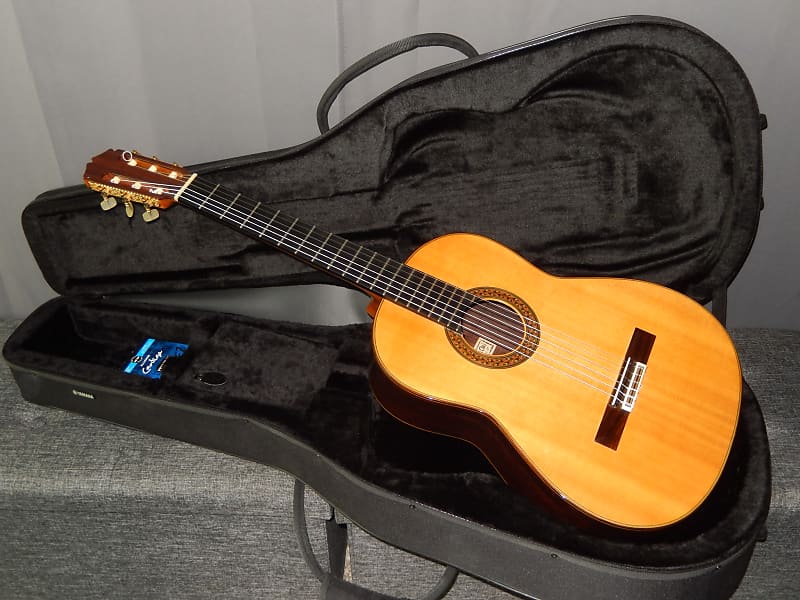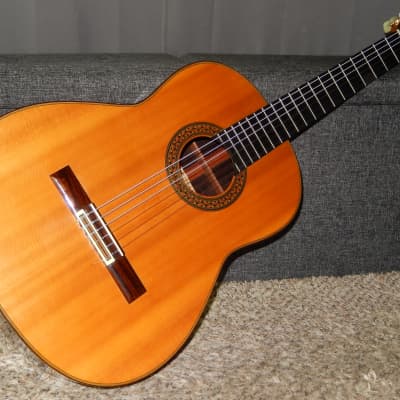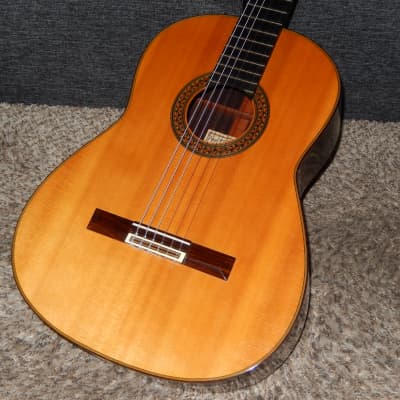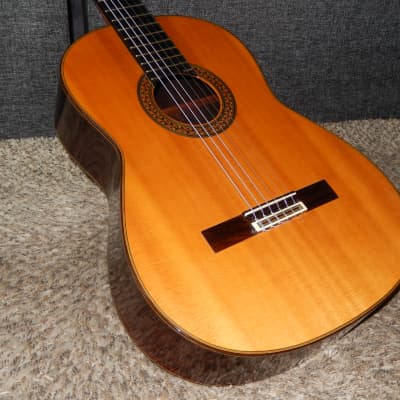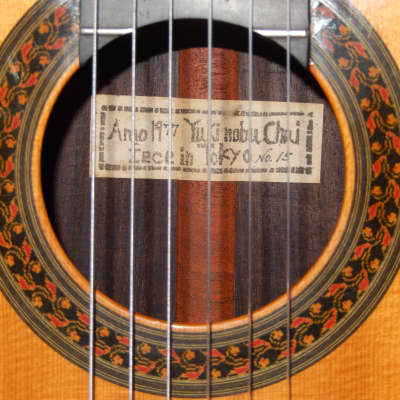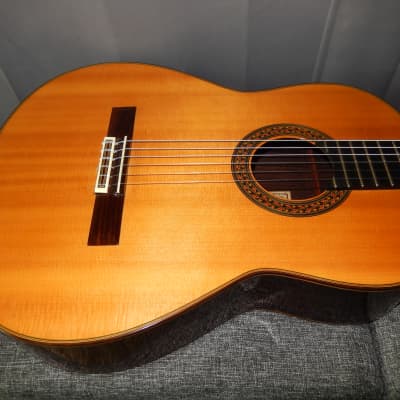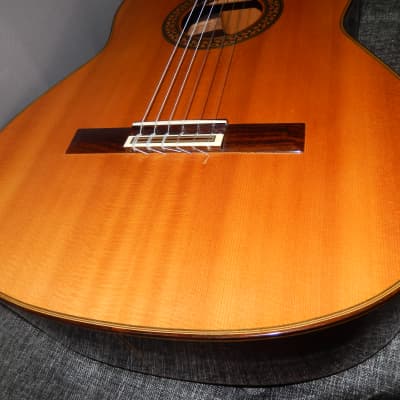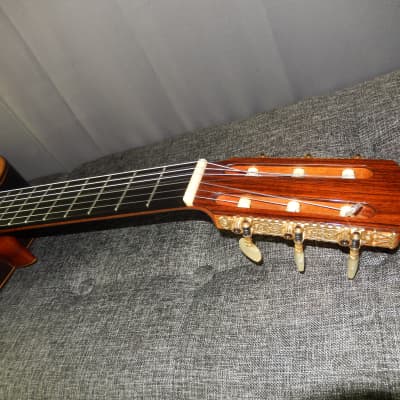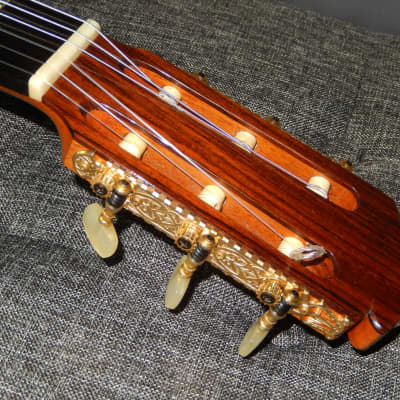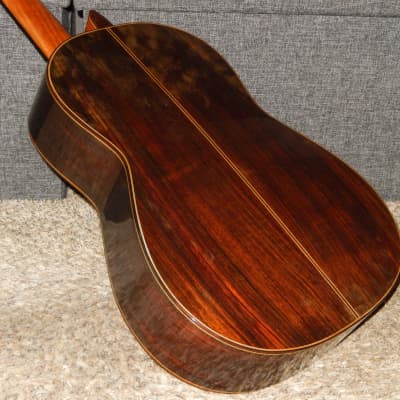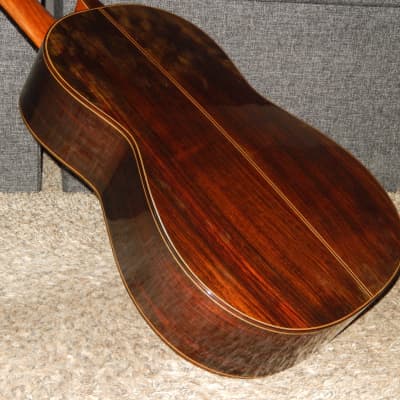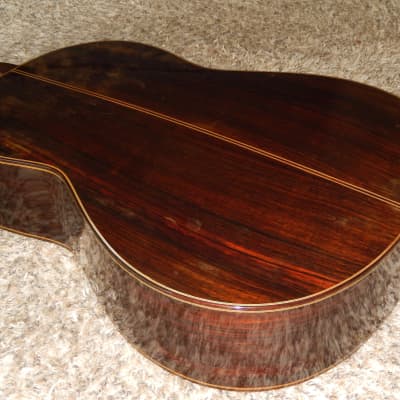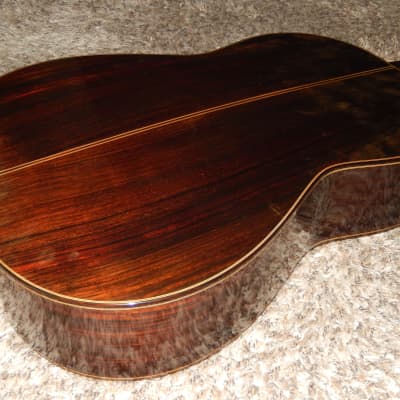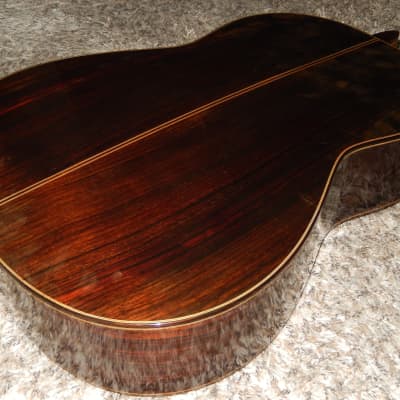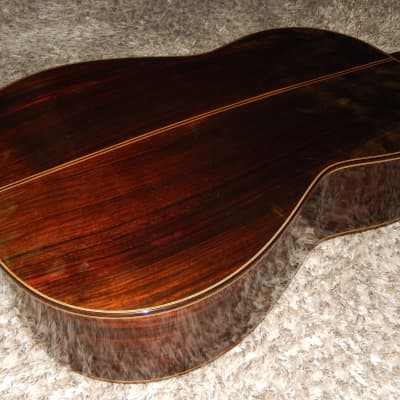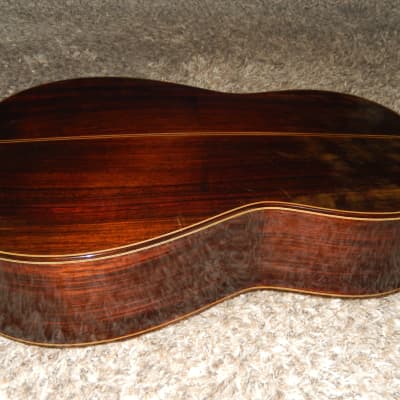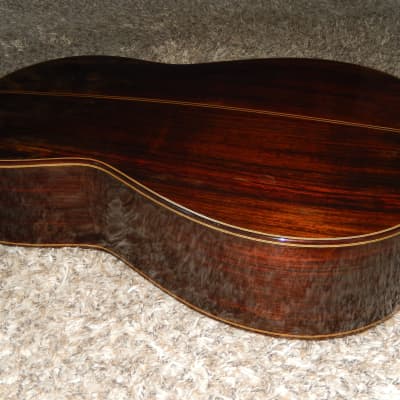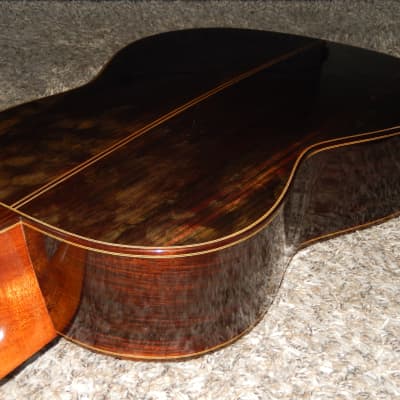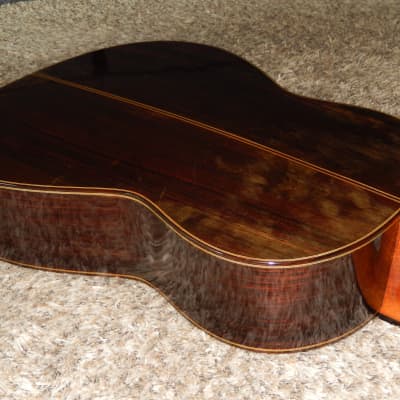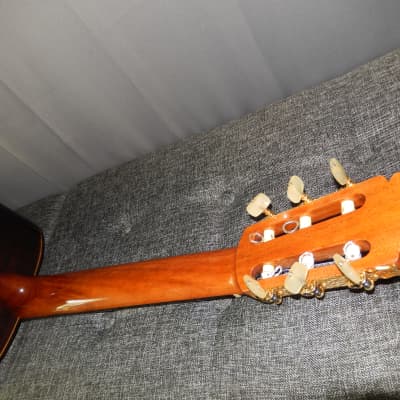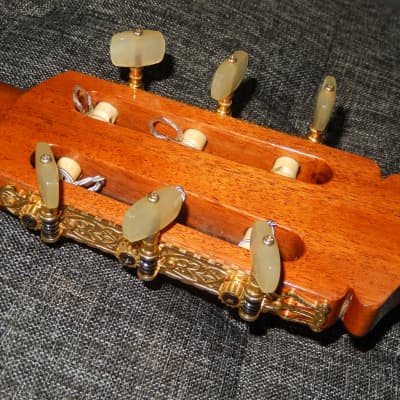Several hundred guitars I have sold in the past are presented at Facebook.com/Victors.Guitar.Library.
Yukinobu Chai Classical Concert Guitar No15 1977
This guitar was made in 1977 by Master Luthier Yukinobu Chai.
Yukinobu’s career started in late 1960s and over the years he became one of the highest respected luthiers in Japan. Most likely the major reason for that were very moderate prices for his wonderful instruments.
In that respect Yukinobu had a business philosophy very similar to that represented by Ryoji Matsuoka, Kazuo Yairi or brothers Hiroshi and Mitsuru Tamura. In 1983 top Masaru Kohno model 50 or Sakazo Nakade Master 50 were priced 500 000 yen. In 1984 top Masaru Kohno model Maestro or Sakazo Nakade Master 80 were priced 800 000 yen. By 1985 Yukinobu Chai and Tamura brothers were still pricing their top models at 500 000 yen even though their instruments sounded no different than those made by the “elite” luthiers. In 1985 the top Ryoji Matsuoka models were M200 & MH200. Kazuo Yairi's top model was YC200.
In early 1980s Yukinobu became the major supplier for Niibori School of Guitar Ensemble, making not only whole range of prime (regular) models but also many alto, soprano, bass and contrabass guitars. Since Yukinobu's passing in 2011, his workshop has been managed by his son Yukihiro, a great luthier on his own. Yukinobu's most famous pupils are Ichizo Kobayashi, Tatsuro Kobayashi, Sakae Ishi and Kuniyoshi Matsui.
Introduction from Chai Guitar Craft Facebook page:
Thank you for visiting our WEB site.
My father, Yukinobu Chai, started the guitar crafting about 55 years ago at Tamagawa Gakuen, Tokyo Japan. He was interested in making the violin when he was a student. Since then, he added many strings instruments. In 1960's, it was very popular for Japanese to play the classic guitar. This was influenced by famous movie "Jeux interdits"
My father never get a lesson from other violin builder. He just learned all from book and real violins. For Guitars, Of course, he never made it before. He has transferred some constructions from Piano. It made Chai Guitar sound & tone. He was always trying to reach his aimed tone "Sound that spread richly".
I always look at his works beside him. Naturally I started to help him. Well, it was about 20 years ago. He passed away several years ago. Now, I'm doing his work and trying to establish the Chai Guitar Brand worldwide.
Chai Guitar Craft
Yukihiro Chai President
To my ears, Yukinobu Chai was one of the best Japanese luthiers ever and remains my favorite Japanese luthier since I encountered his guitars made in 1970s. I am totally not bothered by discolorations of finishes on his guitars from that era. After selling several of his guitars I know that truly experienced guitarists looking for a “truly special” instrument are not bothered by these cosmetic imperfections either. I deeply understand why Hiroki Niibori has decided to offer Yukinobu such lucrative contract.
In the mid1970s Yukinobu was still a relatively unknown luthier and his prices were still somewhat lower than those proposed by elite luthiers. Until 1974 Yukinobu's model 10 was made with solid figured Brazilian Rosewood b/s. Until early 1976 his model 10 was still made with straight-grain Brazilian Rosewood b/s. During the same era (1975/76) Yukinobu's models 6 and 8 were made with solid Indian Rosewood b/s.
In 1977 No15 was Yukinobu's 3rd from the top model of that year. Higher models were No20 and No30, both made with highly figured Brazilian Rosewood b/s. Model No15 was made with more or less figured Brazilian Rosewood.
This guitar was priced 150 000 yen in 1977. Just a couple later the same guitar would be labelled as No20 and priced 200 000yen, and still made with Jacaranda b/s. Just like many other less prominent Japanese luthiers of that era, Yukinobu Chai simply had to deliver much more for the same price in comparison with Masaru Kohno models. In fact, you will never find Kohno No15 or No20 that would sound even close to guitar you are looking at. This guitar can be compared only to Kohno’s model No30 from the same year.
This guitar offers immense volume and super response, combined with simply breathtaking tonality: sweet, colorful, ringing and somewhat metallic (violin like) trebles, deep somewhat metallic and full of overtones (cello like) basses, all well balanced, with superb note clarity and separation, and all with very impressive sustain. When chords are played this guitar behaves like Symphony Orchestra. It is simply gorgeous instrument to play.
If you wanted to purchase similar class brand new guitar made by leading Japanese luthier, you would have to pay no less than $8000. If you ordered such guitar made with old stock solid figured BR, 50 years old Yezo Spruce top and shellac finish it would be priced at least $12000.
This guitar remains in "excellent for its age" overall condition. In fact, besides one string splash mark below the bridge (string E1), and few ultra-light scratches on the back, body of this guitar doesn’t bear any conspicuous dents or scratches. Very importantly its quite slim neck is straight, fingerboard and leveled frets remain in excellent condition, while its action is very "player friendly".
What is visible to the naked eye (and greatly exaggerated in the pictures) are "fingertip-like" discolorations embedded within the finish on the back. Such discolorations are quite common on Japanese guitars of that era, not only on those made by Yukinobu and most pronounced on guitars made with Brazilian Rosewood b/s. This finish cloudiness and "fingerprints" certainly don’t affect the tonality or playability of this very precious guitar.
Such cloudiness occurs only within the finish while the wood itself doesn’t lose its natural color. It is a result of mixing finishes, like covering shellac with cashew lacquer. After cashew lacquer dries it is harder, more durable and scratch resistant than shellac. Later as the shellac ages it often becomes “cloudy”. The intensity of this cloudiness depends on what shellac formula was used. Sometimes instead of uniform cloudiness, there are only a few or several “fingerprints” visible. These “fingerprints” are traces of shellac pads.
French polishing is the application of shellac with the use of shellac pads. Shellac finish on guitars is always applied by “French Polishing”. On other wooden items and furniture shellac is usually applied by paint brush.
The great majority of Japanese luthiers while finishing their high-end models, were using very thin coat of cashew lacquer as the last layer over the shellac usually only on the back and sides. Some luthiers (like Masaru Kohno, Ryoji Matsuoka, Hiroshi Tamura) were using this approach also on the soundboards. Cashew lacquer is more durable and resistant to wear and scratches etc. and that is why Japanese were using this method. Therefore, when there is Cashew lacquer on the surface, it is very likely there is a shellac underneath.
Specifications:
Top: Very Tight Grain Solid Yezo Spruce/Cashew lacquer (over shellac)
Back & Sides: Solid Brazilian Rosewood/Cashew lacquer (over shellac)
Neck: Mahogany
Fingerboard: Ebony
Scale: 650 mm
Nut width: 51 mm
Its action is set to 3.50 mm under E6 and 3.00 mm under E1, with very little extra room on the saddle).
This guitar will be shipped in a used hard polyfoam case in very good condition.
When contemporary Japanese luthiers are using 40+ years old soundboards to make “all solid woods” guitar it is priced at least $5000USD. Guitars with artificially aged (“baked”) soundboards are priced at least $4500USD. Solid top models with 40+ years old soundboards are priced at least $3500USD. American, Australian and European luthiers usually charge 50% more.
It is a matter of basic education (not beliefs) to realize that 50+ years old soundboard of this guitar alone is worth $2500USD.
Real Value of Japanese Vintage Guitars
The key to understand value of vintage Japanese guitars is to acknowledge galloping price inflation (devaluation of Japanese yen) during 1960s & 1970s. This inflation slowed down in 1980s.
During 1960s and most of 1970s model numbers of Japanese guitars were strictly interconnected with their prices in Japanese yen. By early 1980s and during following decades model numbers were no longer strictly associated with their prices. Some Japanese guitar makers introduced model names instead of model numbers. Others were still using model numbers with addition of letters and/or other symbols.
It is then important to understand that two Yamaha GC10 guitars made 10 years apart are two instruments of totally different class. The same applies to any other Japanese maker/brand.
The logical way to estimate the true class of any given Japanese made instrument is to compare its price with the average annual salary of wage workers in Japanese private sectors. This salary was: 450 600 yen in 1965 - 825 900 yen in 1970 - 1 868 300 yen in 1975 - 2 689 000 yen in 1980 - 3 163 000 yen in 1985 - 3 761 000 yen in 1990 - 4 107 000 yen in 1995 - 4 082 000 yen in 2000.
Any guitar priced 100 000 yen in 1970 (labelled as No10 or No100) would be priced 200 000 yen in 1975 (relabeled to No20, No200 or 2000), 300 000 yen in 1977 (labelled as No3, No30 or 3000) and 500 000 yen by 1985 (labelled as No50 or 5000).
Starting in 1977 Masaru Kohno introduced his new models No40 priced 400 000 yen and No50 priced 500 000 yen. By early 1980s Kohno started using model names instead of numbers and was steadily raising their prices without changing model labeling. His very top model 50 became model “Special”, and a decade later it became model “Maestro”. Naturally, all other Japanese guitar makers were doing similar pricing (labelling) upgrades.
Knowing all of that, you can bet on that Masaru Kohno No50 made in 1982 is practically the same grade instrument as Kohno No20 made in 1972, or Kohno no 30 made in 1975.
In early 1970s the lowest Ryoji Matsuoka (all plywood) model was 10, followed by (solid top) models 15, 20, 25, 30, 40, 50, 60, 80 and (all solid woods) models 100 and 150. Models 50, 60 and 80 were made with non-solid figured Brazilian Rosewood (double) back and sides and top model 150 was the only one made with solid figured Brazilian Rosewood b/s.
In 1980 the lowest Matsuoka model was (all plywood) 20, followed by (solid top) models 30,40,50, 60 and all solid woods models 80,100,150 and 200. By 1990 the lowest Matsuoka model was M40 and the highest was M300. By 2010 the lowest Matsuoka model was M50 and the top model was M270.
You can bet that Ryoji Matsuoka model 50 from 1980 is of the same grade as model M100 from 2000, model 100 from 1980 is of the same grade as model M150 from 2000, model 150 from 1980 is of the same grade as M200 from 2000 and model 200 from 1980 is of the same grade as model M300 from 2000.
It is important to mention that if modern era luthiers are using 40+ years old woods to make an “all solid” wood classical guitar, its price is minimum $8000.
All vintage guitars made with Brazilian Rosewood are especially precious, including those made straight grain varieties and those with non-solid b/s.
Because response and tonal properties of Spruce soundboards are improving over time, long seasoned Spruces are far more precious than long seasoned Cedars.
It is not very difficult to find out what are current prices of such guitars made by world’s leading luthiers.
Important message for Australian buyers:
USPS International Priority Mail packages destined for Australia have quite restricted size (max. length is 42” and max. length + girth is 97”). For these reasons I must use the case that is no longer than 41” and therefore it may be different than the one you see on the pictures. You should ask me for any other details prior to making a purchase.
